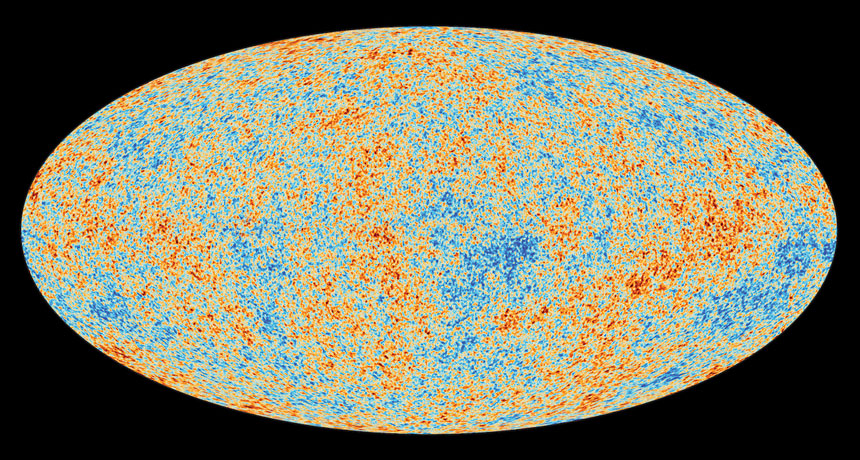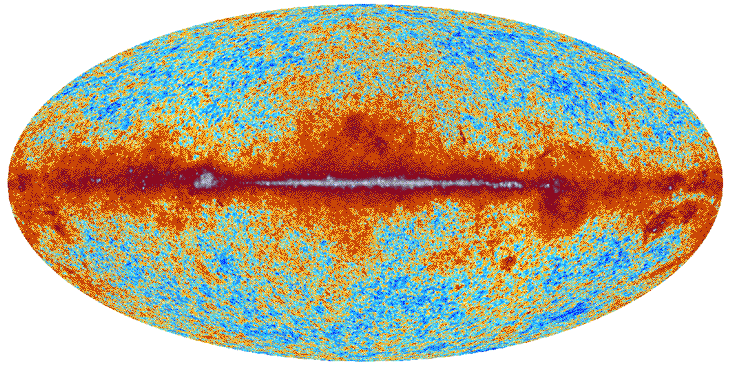
TAKE A BOW It’s the cosmic finale for the Planck satellite, which measured the oldest light in the universe, the cosmic microwave background (shown).
ESA, Planck Collaboration
- More than 2 years ago
A spacecraft that revealed details of the hidden tapestry of the infant cosmos has had its last hurrah.
Scientists have unveiled the final result from the European Space Agency’s Planck satellite, which observed the oldest light in the universe — the cosmic microwave background — from 2009 to 2013. During its mission, the spacecraft provided new details of the intricate patterns woven into that light, across the entire sky. Now, a collection of postmortem papers posted July 17 at arXiv.org are the putting the finishing touches on the measurements, released in a series of studies beginning in 2010 (SN Online: 7/5/10).
Since its launch, Planck has helped scientists settle on a detailed, cohesive story of the universe’s youth, its life history and its current properties, accounting for everything from the contents of the universe, to its age, to how fast it is expanding, and when its first stars formed.
Most importantly, Planck has left physicists with few options other than to accept the hard truth that we don’t understand what makes up a majority of the universe.
Before the spacecraft made its measurements, scientists had a theory of the universe’s makeup: It’s composed of a quirky cast of characters, including the mysterious, unidentified dark energy and dark matter. Dark matter is thought to be a type of subatomic particle, thus far detectable only via its gravitational effects on visible matter, while dark energy drives the accelerating expansion of the universe.
Now, that concept — strange as it may seem — has been strongly confirmed by Planck, leaving no other theories that come close to explaining Planck’s data. “There is no other player in town,” says cosmologist Shaul Hanany of the University of Minnesota in Minneapolis. “And the fact that there’s no other strong candidate is to a large extent a contribution of Planck.” That means that dark matter and dark energy are likely here to stay. According to Planck’s final tally, the universe’s matter and energy are divvied into about 68 percent dark energy, about 27 percent dark matter, and a paltry 5 percent normal matter — which includes everything we know and love.
The fact that no one knows what dark matter and dark energy are “should make everybody uncomfortable,” says cosmologist Scott Dodelson of Carnegie Mellon University in Pittsburgh. But this picture, for all its quirks, explains Planck’s data extremely well, says. “We’re not living on the backs of turtles,” he says, referring to some cosmic mythologies that suggested the Earth rested on the creatures’ shells.
Instead, scientists have staked their cosmology on the back of Planck. Mapping the cosmic microwave background across the entire sky at an unprecedented level of detail, Planck measured both the temperature of the light and its polarization, the orientation of wiggling electromagnetic waves. The observations provided an essential data trove, allowing scientists to catalog the universe’s properties to better precision than ever before.

“It remains the best overall determination of the large-scale characteristics of the universe,” says astrophysicist and member of the Planck team Jan Tauber of ESA’s European Space Research and Technology Centre in Noordwijk, the Netherlands.
Planck revealed that the universe was slightly older than thought (SN: 4/20/13, p. 5), helped pinpoint when the first stars appeared (SN Online: 2/9/15) and detailed how structures like galaxies and galaxy clusters form. Another claim to fame: Planck shattered hopes that scientists had spotted evidence of inflation, a hypothetical period just after the universe’s birth during which the cosmos expanded extremely rapidly. Planck showed that swirls in the polarization of the cosmic microwave background, originally thought to be due to inflation, were caused by dust (SN: 2/21/15, p. 13).
The new result uses the same data as Planck’s last result, released in 2015 (SN: 3/21/15, p. 7). But this time around, scientists have improved their analysis of that data. In earlier studies, the researchers were not fully confident in their understanding of the polarization data. Now both temperature and polarization are considered solid, Tauber says.
But puzzles still lurk. Scientists have used Planck’s observations of the cosmic microwave background to estimate how fast the universe is expanding today. That number, however, disagrees with a measurement of the expansion rate made using distant exploding stars (SN: 8/6/16, p. 10). The mismatch could hint at the existence of a new subatomic particle or the possibility that dark energy varies over time. But measurement errors in one or both types of experiments could also be to blame.
“It’s tricky,” says cosmologist Renée Hložek of the University of Toronto. “There’s something interesting happening, and we need to figure it out.” Before getting too worked up, scientists need to be sure all aspects of the experiments are fully understood, Hložek says, and confirm the results with other experiments.
After switching Planck off in 2013, scientists are now preparing for the next stage of space-based cosmic microwave background experiments. Plans are under way for possible future missions, which, like Planck, would survey the entire sky. Hanany is studying the potential for a NASA mission called the Probe of Inflation and Cosmic Origins, or PICO. Other proposed space missions, such as LiteBIRD and the Cosmic Origins Explorer, are also in the planning stages. And additional ground-based telescopes, which would map smaller slices of sky, are in the works.
Such efforts, scientists hope, might eventually provide evidence for inflation that doesn’t turn to dust.







